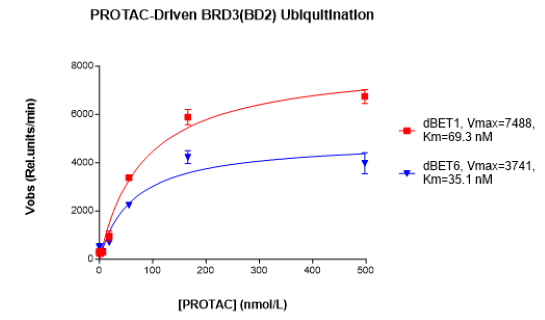
dBET1 and dBET6 PROTAC-Driven BRD3 (BD2) ubiquitination, two similar PROTACS with different linker sizes
PROTAC-Driven Ubiquitination Assay Kit for BET Bromodomains
82291
Product group Assays
Overview
- SupplierBPS Bioscience
- Product NamePROTAC-Driven Ubiquitination Assay Kit for BET Bromodomains
- Delivery Days Customer7
- CertificationResearch Use Only
- Scientific DescriptionThe PROTAC-Driven Ubiquitination Assay Kit for BET Bromodomains is designed for the testing and profiling of PROTACs targeting the bromodomains on the BET (bromodomain and extraterminal) protein family. After tertiary complex formation between the E3 protein, the PROTAC and the protein of interest, ubiquitination of the target protein is a critical step preceding its degradation. The PROTAC-Driven Ubiquitination Assay Kit for BET Bromodomains comes in an AlphaLISA® format with enough optimized assay buffer, purified recombinant E1 (UBE1), E2 (UbcH5b), and E3 enzymes (Cereblon complex), BRD3 (BD2) (bromodomain-containing protein 3) (amino acids 305-417) as target protein, ATP, and biotinylated ubiquitin for 384 reactions. This kit also contains the PROTAC dBET1 as the control, and JQ1 as control inhibitor. dBET1 or a PROTAC® of interest is incubated with Cereblon complex and BRD3 (BD2), bringing them in close proximity. Ubiquitination reaction occurs following the addition of E2 enzyme, ATP, biotinylated ubiquitin, and, finally, E1 enzyme. Once ubiquitination has taken place, AlphaLISA® donor and acceptor beads are added. BRD3 (BD2) contains a GST-tag, which is recognized by GSH-AlphaLISA™ acceptor beads. Ubiquitinated BRD3 (BD2) contains biotin-ubiquitin, that binds to Streptavidin donor beads. Upon excitation of the donor bead, a singlet oxygen is generated. The singlet oxygen excites the acceptor bead, which emits light. The resulting signal is directly proportional to the level of ubiquitination of BRD3 (BD2).
- Storage InstructionSee manual
- UNSPSC41116133







